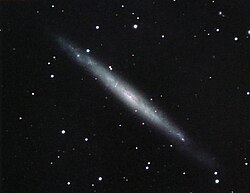Central massive object
Appearance
 The star-like nucleus at the center of this edge-on spiral galaxy, NGC 4244, is a central massive object. | |
Central massive object (CMO) refers to a mass concentration at the center of a galaxy. It can be either a supermassive black hole or a nuclear star cluster.
The most massive galaxies are thought to always contain a supermassive black hole (SBH); these galaxies do not contain nuclear star clusters, and the CMO is identified with the SBH. Fainter galaxies usually contain a nuclear star cluster (NSC). In most of these galaxies it is not known whether a supermassive black hole is present, and the CMO is identified with the NSC.[1] A few galaxies, for instance the Milky Way and NGC 4395, are known to contain both a SBH and a NSC.[2]
The mass associated with CMOs is roughly 0.1–0.3% times the total mass of the galactic bulge.[1]
See also
References
- ^ a b Merritt, David (2013). Dynamics and Evolution of Galactic Nuclei. Princeton, NJ: Princeton University Press.
- ^ Nishiyama, S.; Schödel, R. (2012). "Young, Massive Star Candidates Detected throughout the Nuclear Star Cluster of the Milky Way". Astrophysics. Solar and Stellar Astrophysics. arXiv:1210.6125. Bibcode:2012yCat..35490057N. doi:10.1051/0004-6361/201219773.
